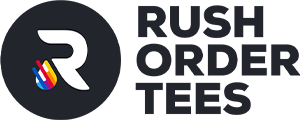
One of the most popular hat styles in the world is the beanie. It's also one of the best kinds of hats to customize. But with increasing popularity comes lots of different types of beanies. There is a lot to choose from, and we're here to sort it out with our list of the top 5 beanies and the best ways to customize them.
What is a beanie?
A beanie is simply a knitted winter cap that fits snugly on any head. They are made from wool, cotton, blends, or synthetic materials and tend to be soft, warm, and stretchy. Beyond that, there are lots of different types of beanies. They can have a folded cuff, a prominent peak, a ribbed texture, a pompom, and even a brim.
Also known as a stocking cap, a ski cap, or a skull cap, the name "beanie" comes from the early 1900s when the slang term "bean" referred to the head. This simple hat style was popular among factory and construction workers for keeping their hair and scalp warm and clean while on the job and fishermen on cold voyages.
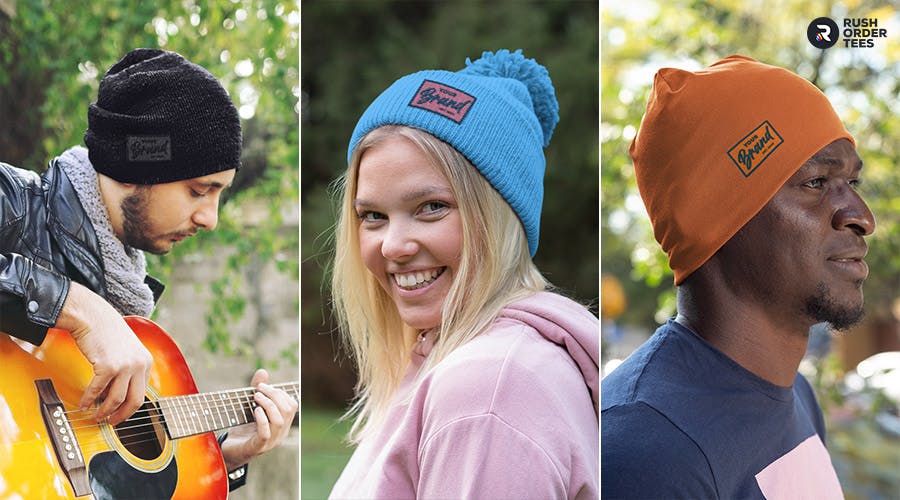
Despite the working class origins (or perhaps because of it), today's beanies are fashionable and worn by everyone from celebrities to hipsters to average Americans. Beanies are available in various styles and materials and are easy to brand with your logo.
The 5 most popular types of beanies
Beanie styles have come a long way, including everything from short brims or visors to earflaps and reversible functions, but the classic types still rule. Here are the top 5 types of beanies:
1. Slouch Beanie
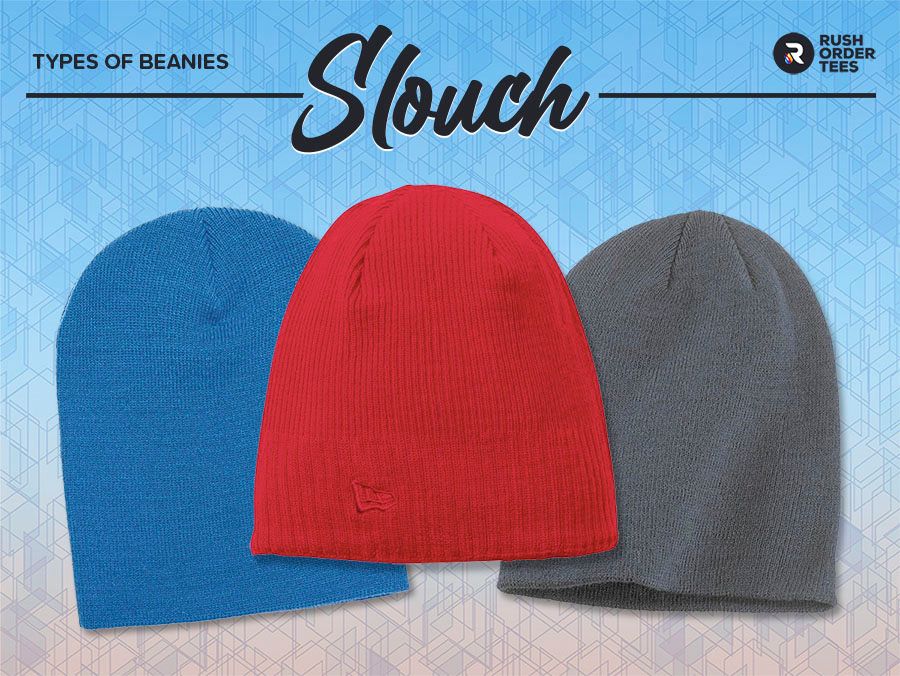
The classic, standard beanie, which has recently come to be known as Slouch, has a generous size that covers the ears and back of the neck, with a soft peak on the top of the head, and is cuffless. While the edge can be folded up into a cuff, generally, these are worn without it, and it sits farther back on the head and with the peak drooping a bit in the back (hence the "slouch" name).
Best Slouch beanies for branding
Good: Big Accessories Knit Slouchy Beanie (BA519) - Simple and streamlined, this classic slouch beanie has a great price, and its smooth knit is perfect for an embroidered logo that pops. Comes in 2 colors.
Better: Yupoong Adult Knit Beanie (1500) - This Yupoong 1500 beanie is comfortable and warm. 100% turbo spun acrylic knit, tight-knit for easy embroidery, hypoallergenic, hand washable. Comes in 13 colors.
Best: New Era Knit Beanie (NE900) - With 1x1 rib knit at the top and 3x3 rib knit at the bottom edge, this fleece-lined beanie is a warm, laid-back favorite. Tonal embroidered New Era flag. Comes in six colors.
2. Fisherman Beanie
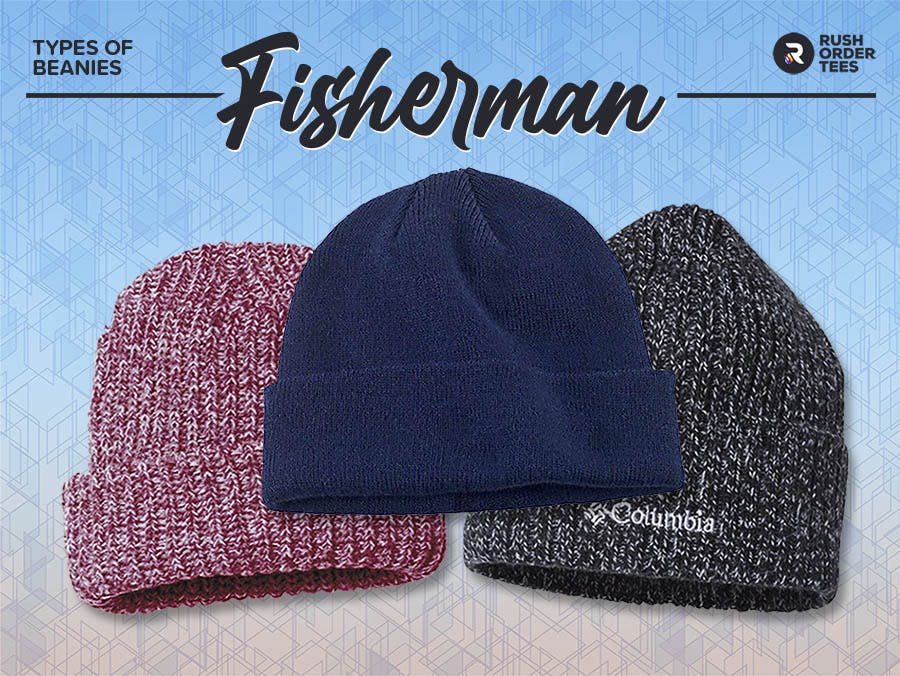
Another classic is the Fisherman cap, also known as a Cuffed Beanie, Watch Cap, or Hipster Hat. It's been popular throughout the centuries and is more popular than ever. Although cuffless beanies can be cuffed, Fisherman beanies are often sewn to keep the cuff in place. These are worn close to the head like a skull beanie, with the cuff sometimes sitting above the ear.
Best Fisherman beanies for branding
Good: Big Accessories Knit Watch Cap (BX031) - Stay warm and sporty this winter with the Big Accessories Knit Watch Beanie. This beanie features a desirable 6-seam construction that keeps it extra thick and helps to make it last longer.
Better: Sportsman Chunky Knit Cuffed Beanie (SP90) - Keep your head warm and let the cold wind blow in the Sportsman Chunky Knit Hat. Made from 100% acrylic, this hat will keep your head warm for hours. Comes in 8 colors.
Best: Columbia Watch Beanie (146409) - This Columbia Watch Beanie is made of 96% acrylic and 4% nylon fabric and will keep your head warm against cold and chilly winds. Comes in 3 colors.
3. Skull Cap
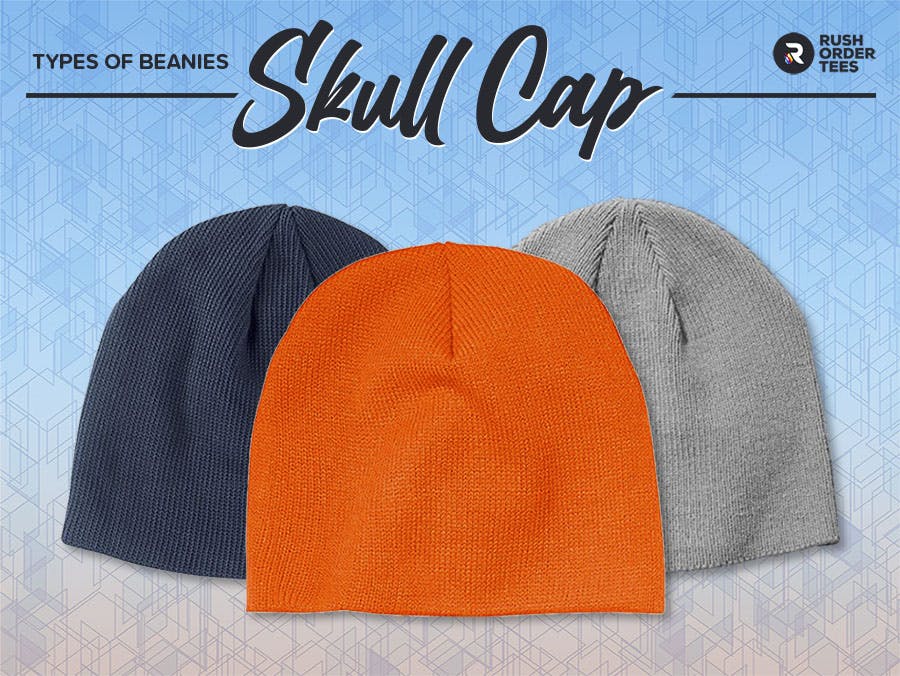
The skull beanie or "skully" is exactly what you think: a low-profile cap conforms to the head like a skull. It's simple, with no cuff, peak, or slouch. When you want the most basic form of the beanie, the skull cap is it. Brand it with a small logo on the side for a stylish and casual look.
Best Skull Caps for branding
Good: Port & Company Beanie (CP91) - A warm must-have accessory, this beanie is available in various solid colors or with contrasting trim. Design now and give it a try!
Better: Big Accessories Knit Beanie (BX026) - This Big Accessories Knit Beanie is an excellent value that doesn't sacrifice quality. This single-layer knit beanie features 6-seam construction, 8½" length, and is 100% acrylic knit. Perfect for ski trips, cold-weather sports, or casual everyday wear.
Best: Econscious Organic Beanie (EC7040) - Econscious Organic Beanie is a 100% certified organic cotton beanie that is eco-friendly and comfortable with a double-layer knit rib pattern and a 9-inch length. This beanie is perfect for providing warmth, comfort, and style all at once.
4. High Top Beanie

A high-top or "peaked" beanie is a cuffed beanie with a longer length, typically rising up rather than sloping down. It's like having a conehead, except it looks good. These beanies tend to be thicker knit, and some with ribbing texture. This kind of hat can make you up to 4" taller.
Best High Top beanies for branding
Good: Yupoong Cuffed Knit Beanie (1501) - This hypoallergenic beanie is excellent for sensitive skin and comes in various colors. Make this your own with an embroidered design or logo. 14 colors.
Better: Port & Company Knit Beanie (CP90) - Keep your head well covered during and warm in cooler weather in this cap. With a 3-inch folding cuff for easy embroidery, this cap is great for gifts! 23 colors.
Best: The North Face Truckstop Beanie (NF0A5FXY) - An adjustable cuff means this warm, versatile beanie can be worn with a slouchier look. All that's missing now is your design. Five colors.
5. Pom Pom Beanie
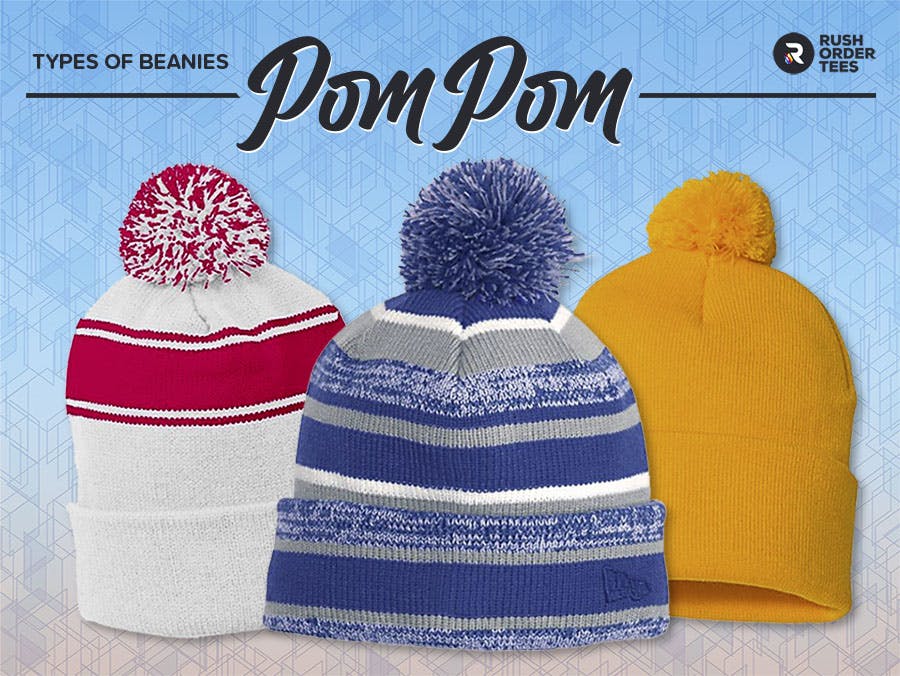
The Pom Pom Cap, also known as a "Ski Hat" or "Bobble Hat," has a fuzzy ball made of yarn fibers that sits atop the peak. These poms have a long history (see the FAQs), and people seem to love them. They've recently become more fashionable, so there are many Pop Pom Beanies to choose from.
Best PomPom beanies for branding
Good: Sportsman Pom-Pom Knit Beanie (SP15) - The classic knit pompom beanie with a great price point. It comes in a whopping 36 color styles, making it the go-to for teams and brands who want to color match.
Better: Sport-Tek Stripe Pom Pom Beanie (STC28) - This one has a bold stripe across the top and a duo-color pompom. Excellent construction and super-soft snug fit. Comes in 7 color combos.
Best: New Era Sideline Beanie (NE902) - With its heather stripes, dual-colored pom, and warm fleece lining, this beanie is frequently spotted on pro football players and fans. A tonal embroidered New Era flag adds subtle character. Has a warm fleece lining and comes in 6 color combinations.
Why people love beanies
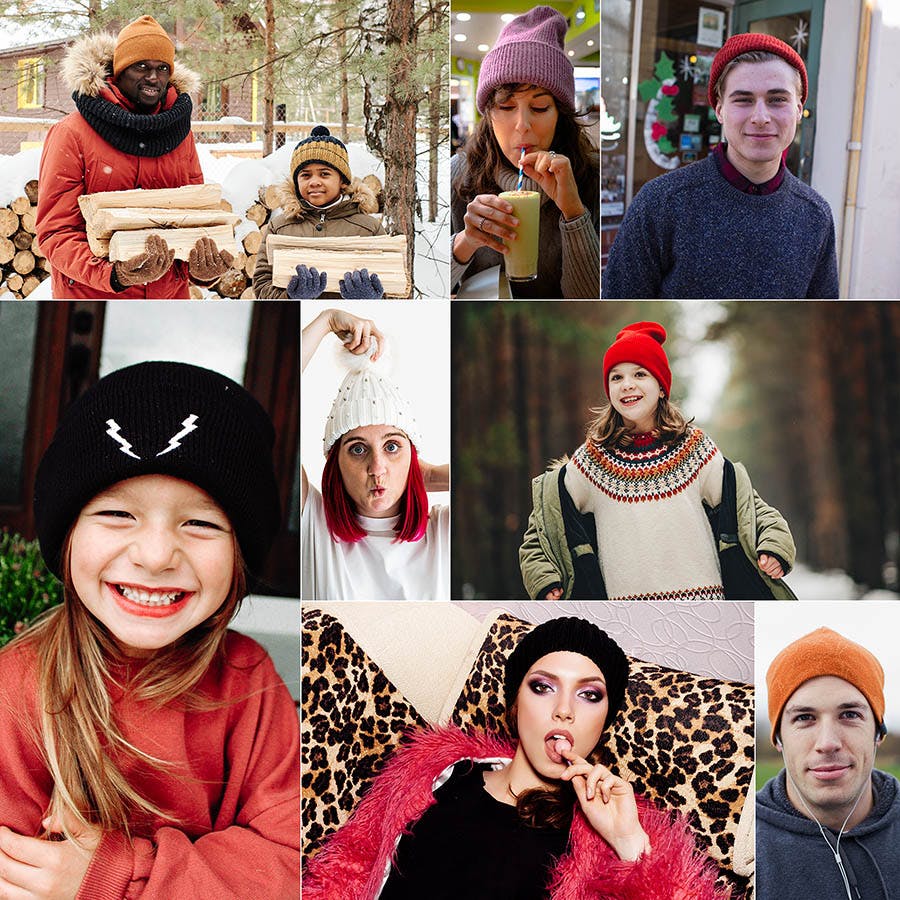
Beanies certainly fit the bill if you're looking for an apparel item that is great for customizing. Popular for company swag, giveaways, and merch, the beanie has a lot going for it. Marketing research shows that over 70% of people wear branded promotional beanies. Here are the main reasons our customers love custom beanies.
- Soft, warm, and lightweight - These obvious factors should not be overlooked. People love soft and warm items, and the lighter weight of beanies is a bonus, especially for shipping costs.
- Stylish & popular - Beanies are trending–and have been for years without slowing down. Whether it's influencers making a fashion statement or the average Joe, people love beanies.
- One size fits all - You can't go wrong with headwear that fits every size bean. Because of the stretchy nature of these knit hats, they are comfortable and snug on any size noggin.
- Easy to customize - Beanies tend to have a large surface area to print or embroider, making them perfect for personalization or branding, with various placement options.
- Affordable - While some fancier beanies can get pricey, for large quantity orders, most styles average in the affordable price range of a T-shirt, including the cost of customizing.
- Versatile - Beanies can be worn for a wide range of uses. Beanies are the go-to hat for fall and winter, whether it's a ski trip, going out to a concert, or just wearing it on your commute.
Best methods to customize a beanie
Choosing the right print method is just as important as choosing the right hat. With over 20 years of experience, we know what works best. Listed below are the top three ways to customize beanies.
1. Embroidery

By far and away, embroidery is the way to go for hats. It can work on just about any kind of beanie and on any material. Embroidery is bold, durable, and professional looking. Whether branding your merch, making company hats for your staff, or creating a coveted swag item, embroidery is the top choice.
2. Patches
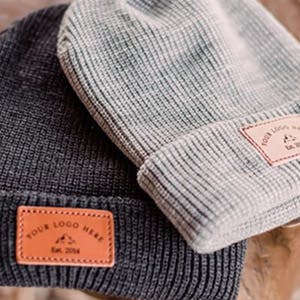
Although not as popular as embroidery, patches are an outstanding and affordable choice for customizing knit hats. Similar to embroidery, they can work for just about any type of beanie. Unlike embroidery, though, they come in a wide assortment of styles and materials. We can even press patches onto unique locations where embroidery can't go.
3. Screenprinting
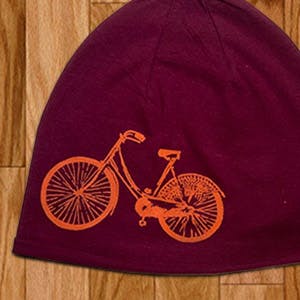
Screen printing is the most affordable, but it has some issues with beanies. Although we can screen print on almost anything, the stretchy and porous surface of knit caps is not ideal. That being said, we have seen some customers succeed with printing small, simple logos on beanies. Using discharge ink is a great option.
Custom beanie design tips
Although customizing a beanie is simple, it's good to use basic design principles when planning your design. Here are the essential tips for creating great custom beanies. We
[example images of custom beanies]
Choose the right style
Take some time to consider the different beanies and colors that will be best for your purpose. If you have a wide audience to think of, a classic style in muted color will work best for most people. If you have a particular demographic you're trying to appeal to (selling merch at a show, for example), you may want to choose one of the more fashion-forward styles.
Keep the design simple
Simple is better for most beanie designs, whether embroidery, prints, or patches. It allows you to keep lines thick and ensure your logo is legible. Complex designs don't do as well on beanies or any other hats. Spend some time with the art file and see where you can simplify. Fine lines and tiny details generally will not translate. Keep it simple, and you will ensure much higher quality customization. For more, read about how to design a logo for embroidery.
Use a quality art file
One of the most important aspects of any custom apparel is having a quality art file. Vector files (.ai, .pdf, .eps) are best because they are clean and scalable. Raster files (.jpg, .psd, .png) can work as long as they are high resolution. Lower-resolution raster files make quality prints and embroidery more of a challenge (but we can still do it!). For more, read about the best file types for printing.
Size logos moderately
The standard size for an embroidered logo is 4" wide x 4" high (or smaller). When your embroidery is bigger than that, it can start getting heavy for the hat (consider the backing material) and also look conspicuous and overemphasized. Certain designs can look OK larger, but generally, keep your logo moderate-sized. Smaller tends to look better, and the hat is likely to get worn more often.
Match the hat color
Some of the best-looking beanies have a subtle logo that is a tone of the color of the hat. Although your logo will not stand out as much, there's a tradeoff: the hat gets worn more often. So find the balance and play with your design colors in a way that maximizes the branding–but also doesn't overwhelm. A good rule of thumb: the more subtle your logo is, the more the hat will get worn (aside from by die-hard fans).
Consider placement
he standard placement for beanies is near the edge, directly on the forehead. Alternative placements are slightly off-center, on the side by the ear, or way on the back. Most placement is along the headband. Certain brands of beanies may have particular construction that allows for creative placement of your logo, such as on the ear flap. If you have an idea, let us know.
Create your own beanies

Now that you know what to know about the top beanie styles, it's time to create your own custom beanies. Have your logo or design ready and jump into our easy-to-use Design Studio to get started on your order today. Our sales team is always available to help if you have any questions.
Beanie FAQs
What material are beanies made from?
Some beanies are made from wool, naturally heat-trapping and moisture-wicking, but most of today's styles are made from fabric blends, including cotton, polyester, fleece, and acrylics. Certain types of beanies feature a knit exterior combined with a fleece inner lining for added warmth.
Why do beanies have balls on top?
The ball on top, known as a "pom," dates back to early human history and has indicated cultural or religious significance, but the true origins are not clear. Some say it's leftover yarn from early "stocking caps," others say it was an inexpensive way to embellish a hat, while others surmise that it was French sailors who popularized it for specific use: so they wouldn't bang their heads on the low ceilings of their ship.
What is the minimum order for beanies?
For embroidery and most other print methods, the minimum order for beanies is six at Rush Order Tees. While not cost-effective, some people would like a small order of custom beanies for their friends or family. To save money and reduce the cost-per-item, larger quantity orders are recommended.
How much do beanies cost?
It depends on several factors, including the size of the order, the complexity of the design, how fast you need them, and, of course, the quality of the product. Custom beanies can range anywhere from $100 each for a minimum order of premium caps down to $10 each for a large order of budget caps, making the average price around $20-$40 per piece.
How much should I price my beanies for retail?
The typical price for a retail beanie is around $30, depending on where you get it and the brand name. Some designer labels can get hundreds of dollars for their beanies, while there are $20 beanies for sale at Target and Walmart. Fledgling sportswear brands and up-and-coming online shops will sell beanies for $30-$40. A good rule of theirs is to mark up the item at least 100% of the manufacturing cost.

Imri Merritt
About the Author
A graduate of the Multimedia program at the University of the Arts in Philadelphia, Imri Merritt is an industry veteran with over 20 years of graphic design and color separations experience in the screen printing industry.
